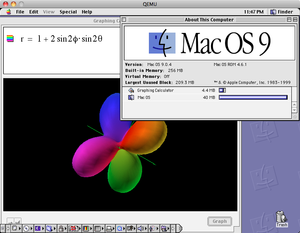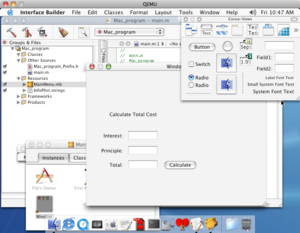Qemu Ubuntu For Mac
QEMU is a generic and open source machine emulator and virtualizer. It is free and open source tool that allows users to create and manage Virtual machines inside the host operating system. The resources of the host operating system, such as Hard drive, RAM, Processor, will be divided and shared by the guest operating systems (Virtual machines). Setup for MacOS VM The MacOS-Simple-KVM GitHub repo is linked from the original post. It is described as 'set up a simple macOS VM in QEMU, accelerated by KVM.' If you ran through setting up the Ubuntu 20.10 daily build in step 4 you'll already have seen QEMU being mentioned. Check if the CPU has the support of hardware for virtualization. On Intel, the processor is Intel VT. Qemu / KVM / MAc os X which run inside WSL2 can't connect to internet Hello. I've installed ubuntu 20.04 on WSL2 and I started a VM with qemu and kvm because I want to boot mac os x as guest / nested VM inside WSL2. How to install macOS in a virtual machine (QEMU) on Linux using Sosumi snap package To install Sosumi you'll need to be able to install Snap packages on your system. This is enabled by default in Ubuntu, and on other Linux distributions follow the instructions from the Snapcraft docs. Install the Sosumi snap package: sudo snap install sosumi.
QEMU (Quick EMUlator) is a type – 2 or hosted hypervisor. Other examples of hosted hypervisors are VMware Player, Oracle VirtualBox & Parallels Desktop for Mac. QEMU, released under GPLv2, supports both machine emulation as well as virtualization. Hence, it is capable to run different Operating Systems and Programs on supported architectures. Download midi gratis lagu qosidah sholawat dangdut. It is written by Fabrice Bellard. At the time of writing the article, the latest stable release of QEMU is 4.1.0. In this article, we would discuss how to setup Virtual Machine using QEMU in Ubuntu distribution.
First, we will install QEMU and create a qcow2 disk image. Then, we would attach a CD-ROM (ISO Image) to the disk image to install an Operating System.
Note: Following operations would require you to have superuser privileges. In case you don’t have one, then contact your System Administrator for assistance.
Install QEMU in Ubuntu
Since, QEMU package is already available in standard Ubuntu repository. Therefore, we would update the Ubuntu repository first to make the latest version of the package available. Thereafter, we would install the package and related dependencies (if any). So, open a terminal and issue the following –
Create a disk image for Virtual Machine using qemu-img
Now, we will create a disk image using command-line utility qemu-img. With qemu-img, we can manage our disk images offline.
where,
-f is used for file format (raw, qcow2 etc.)
For instance,
This would create a file test-img.qcow2 of size 5 GB.
Install an Operating System in Disk image
Next, we need to install an Operating System in the disk image. So, we will attach an installation media (ISO image) to the Virtual Machine. Hence, issue the following in terminal –

where,
-cdrom is for iso_image,
-cpu host is to emulate the host processor. There is a list of supported architectures available – qemu-system-x86_64 -cpu ?
-enable-kvm starts QEMU in KVM mode,
-m is for memory (RAM),
-smp is to specify the number of cores a VM could use.
For instance,
Pehli nazar me kaisa jadu kar diya song download. Now, install an Operating System of your choice in disk image.
Run Virtual Machine (disk_image) through QEMU


To run a Virtual Machine, above code needs to be modified a bit. We would just remove the CD-ROM attached.
For instance,
Qemu Gui Mac Os
In conclusion, we have discussed how to setup Virtual Machine using QEMU in Ubuntu distribution.
Note: For i386 architecture, we can use qemu-system-i386 command in place of qemu-system-x86_64.
To enable audio in QEMU Virtual Machine, follow the article here.

I first learned about libvirt and QEMU three years ago when I wrote a guide on how to virtualize macOS on a Linux system. Today I will be showing the opposite, virtualizing Linux on macOS using the same tools. I was surprised that with so many software developers using MacBooks everyday, nobody has created a guide on how to use libvirt and QEMU with macOS.
Why is libvirt and QEMU better? First of all, it's free and open-source. Unlike Parallels Desktop and VMWare Fusion, you won't need to pay for expensive subscriptions or manage licenses. There does exist an open-source alternative (from Oracle!) called VirtualBox, which works pretty well. However, VirtualBox does not support macOS's Hypervisor.Framework, a virtualization API created to limit kernel modification. This means the installer will ask for admin access to install kernel extensions, a feature Apple is now phasing out for security reasons. QEMU on the other hand has had support for Hypervisor.Framework since 2018. Just say no to kexts!
Furthermore, like many developers, I like to run VMs headless, i.e. without a desktop GUI, so that I can SSH into them. Running VMs in the background seems like a simple feature, but it requires a lot of complex configuration for both VirtualBox and VMWare Fusion. And Parallels wants you buy the Pro Edition to gain access. Market segmentation at its finest.. With libvirt, VMs start headless. Plus, when you shutdown macOS, it sends a shutdown signal to your VMs as well.
To be clear, this method doesn't support USB Passthrough, GPU Passthrough, or bridge networking. But if you just need to test, for example, node.js or nginx on a Linux VM, then this method is great.
Installing libvirt and QEMU
- First, install homebrew, which is a package manager for macOS.
- Run
brew install qemu gcc libvirt. - Since macOS doesn't support QEMU security features, we need to disable them:
- Finally start the libvirt service, with
brew services start libvirt. It will start after boot as well.
Qemu Ubuntu For Mac Virtualbox
Installing Ubuntu Server 20.04

There are two ways to access the virtual display of the VM, either using a VNC client or the virt-viewer program. I recommend RealVNC Viewer. The VNC client is responsive and quick to install, but if you have multiple VMs you need to manually manage the different ports. With virt-viewer, you get a popup with all the VMs currently running, but it is laggy and takes an eternity to install. virt-viewer can be installed through homebrew. The rest of this guide uses VNC.
Create a
vmsfolder in your home directory, and generate a disk image. Change50gto the size of your prefered disk:Download the Ubuntu Server 20.04 Install Image and my libvirt XML template and place the .iso and .xml files in the same folder.
Modify the following elements in the
ubuntu.xmlfile to match your your VM preferences and file paths. Save, then runvirsh define ubuntu.xmlfollowed byvirsh start ubuntu.Start RealVNC Viewer and connect to
localhost. Click theCtrl+Alt+Delbutton to reboot the machine, and quickly pressEscto get into the boot menu. Press the number that matches the Ubuntu Server image.Install Ubuntu Server normally, making sure to enable the SSH server. Once it restarts you can connect to the VM from your terminal by running
ssh -p 2222 user@localhost.To send a shutdown signal to your VM, run
virsh shutdown ubuntu. To force shutdown, runvirsh destroy ubuntu.To forward a port, e.g. port 443 from the VM to port 8443 locally, run the following:
ssh -p 2222 -L8443:localhost:443 user@localhost
Multiple VMs
If you want to create multiple VMs, create an XML file for each machine with a unique UUID, VM name, and VNC port. Also, change the hostfwd argument so that each VM exposes a different port for SSH, e.g. 2223 instead of 2222. After you have defined them all, you can get a list of the VMs that are currently running with virsh list.
Qemu Ubuntu For Mac High Sierra
References:
Qemu On Mac Os
Note: More discussion on Hacker News